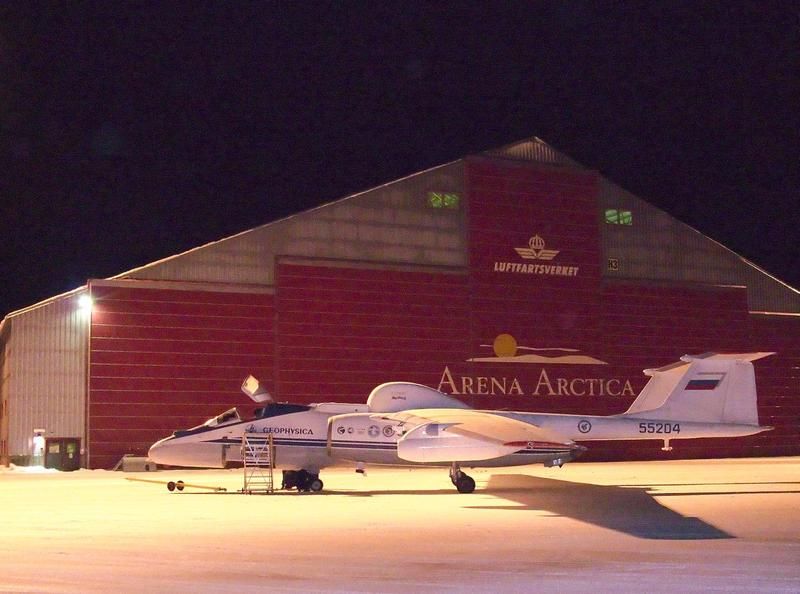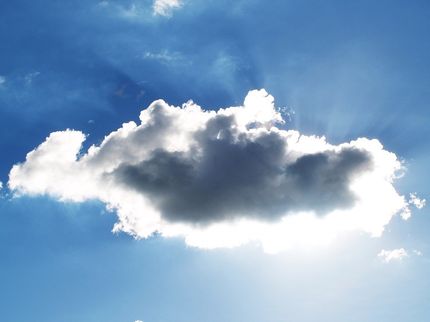Cloud research at extreme altitudes
Scientists succeed in the world's first aerosol particle sampling from polar stratospheric clouds for a better understanding of ozone depletion
Polar stratospheric clouds are crucially involved in the formation of the ozone hole. In order to explore their development, measurements at extreme altitudes are needed. This is what researchers from Mainz and Darmstadt have performed last December over northern Sweden. At 20 kilometers altitude they collected aerosol samples from within these clouds. The samples will now be further analyzed in the laboratory to understand to what extent aerosols derived from anthropogenic activities contribute to the formation of polar stratospheric clouds.

The research aircraft M55 Geophysica at the airport of Kiruna in northern Sweden. The first air sampling from polar stratospheric clouds succeeded with the former Russian high altitude reconnaissance plane in December 2011.
Ralf Weigel, 2011
In fact the scientists from Mainz and Darmstadt had planned to test their new instruments on board a research aircraft. However exceptional stratospheric weather conditions in December 2011 allowed two measurement flights into polar stratospheric clouds. Thus the world's first sampling of aerosol particles, which enable the formation of these clouds, was possible over northern Sweden at a height of 18 to 20 kilometers.
Clouds are normally formed in the Earth's troposphere. In the stratosphere, they develop only in the winter and in the polar regions. At temperatures of minus 78°C and colder, stratospheric clouds, often showing stunning iridescent colors, develop at altitudes of 15 to 30 kilometers.
"Polar stratospheric clouds usually form much later," said Stephan Borrmann, director at the Max Planck Institute for Chemistry and professor at the Institute of Atmospheric Physics at Mainz University, "The large-scale circular air flow in the polar stratosphere, which is essential for cloud formation, was already strong in mid-December, and the low temperatures were reached earlier."
This enabled the scientists to measure the sizes of individual cloud particles and to determine the properties of aerosol particles in the stratosphere with the help of newly developed thermodynamic and optical measuring instruments on board the research airplane "M55 Geophysica". The collected particles are now being investigated further in the laboratory. The aim is to determine to which extent aerosol particles may contribute to the formation of polar stratospheric clouds. These are aerosol particles which are always present in the stratosphere and originate, e.g., from volcanic eruptions, particles that derive from anthropogenic sources such as soot, and also meteoric dust particles.
Polar stratospheric clouds consist of crystals, which contain mainly water and nitric acid, and traces of sulfuric and hydrochloric acid, as well as the cloud-forming aerosols. The clouds play a crucial role in the degradation of the polar ozone, because chemical reactions at the surface and inside the crystals transform inactive, chlorine-containing substances that originate from human activities into active, ozone-destroying chlorine. In the spring, when sufficient sun light is available within this chemically modified stratosphere, the chlorine causes rapid ozone depletion.
To estimate how the ozone depletion develops in the future, numerical models are used, whose quality largely depends on a detailed knowledge of the physical and chemical processes. To precisely simulate for instance the formation of polar stratospheric clouds, open questions must still be clarified with the help of in-situ experiments. However, to deploy a suitably instrumented measurement platform in such extreme heights is an immense technological challenge to both the aircraft and the scientific instruments.
The adopted research aircraft Geophysica is a former Russian high altitude reconnaissance airplane and started at each time from Kiruna in northern Sweden. The investigations were part of the measurement campaign ESSENCE from the Juelich Research Center (FZJ) and Karlsruhe Institute of Technology (KIT).
"If the current meteorological conditions remain stable in the stratosphere until March, a considerable ozone hole is likely to form over the Northern Hemisphere in the spring of 2012," explained the atmospheric researcher Borrmann. "We can already state this based on the observed clouds and the trace gas measurements." An ozone hole as known from the Antarctic meanwhile regularly develops in the Northern Hemisphere too. Once the stratospheric flows switch to summer conditions, the lost ozone is again replaced incoming ozone from the mid-latitudes.





























































